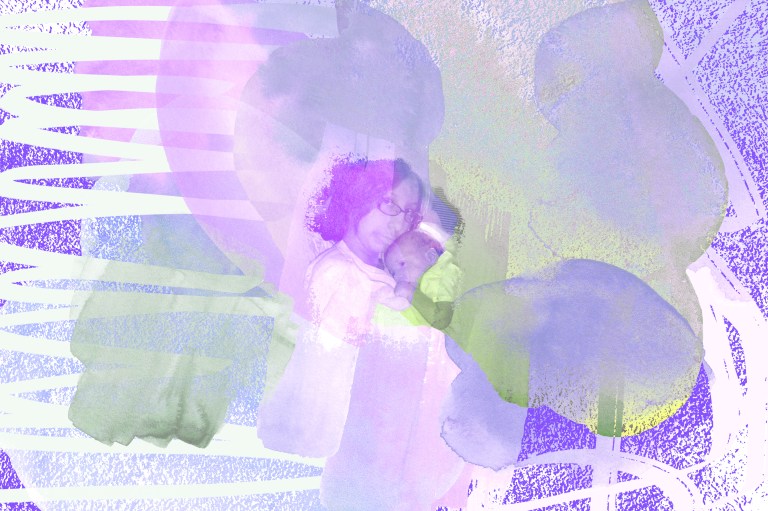
How I Practice Body Positivity While Living With Hidradenitis Suppurativa
By ![]() Katy Shusta
Katy Shusta
Eighteen years ago, I started experiencing intermittent but recurring abscesses on my skin. These abscesses grew to the size of a golf ball and then drained. After they drained, they always left behind large purple-ish grey scars. These scars started to stitch together over time as more abscesses came and drained. After a while, they spread over my skin on my thighs, armpits, and breasts.
These abscesses and scars are from a chronic illness called Hidradenitis Suppurativa, or HS. HS is a chronic inflammatory skin condition that causes painful recurrent boils and abscesses on the skin, generally on the groin, buttocks, thighs, breasts, and armpits. The abscesses can grow to the size of a tennis ball. Sometimes they burst open and drain. Sometimes they drain under the skin and create tunnels. Either way, they always leave behind scars that tend to be large and purple or red. These scars never go away. HS is a progressive disease, which means it will continue to get worse over your life.
As you may be able to tell, HS is an extremely visible disease. The boils, abscesses, nodules, inflammation, and fistulas can be seen on the skin. If a flare opens and drains, the drainage can be seen on the skin or clothes. No matter how an HS flare happens, it will always leave scars and scar tissue that is permanently visible on your skin. Finally, not only is HS visible on the skin, but it can create mobility challenges as well. HS scars and fistulas can limit mobility and physical activity can be an HS trigger. Because of these reasons, HS can make it difficult to accept and love your body.
When I was younger, my HS was less severe and much easier to hide. I did not have scars on my cleavage or neck or abdomen. I had fewer scars on my armpits and thighs. Therefore, I could easily hide this disease by wearing longer shorts and shirts that hid my scars. As such, most people in my life did not even know I struggled with HS. I was embarrassed of my HS but I did not have to explain it to other people. I dealt with the HS by ignoring it instead of processing it and therefore was ignoring a huge part of my body.
As the HS spread and worsened, so did my mobility. I was no longer able to hide this disease and started talking to important people in my life about it. It became harder for me to feel confident in my body and I felt frustrated with my limitations. I was embarrassed by the more unseemly symptoms of HS, such as the scars and drainage. When people asked about it, I was mortified.
A particularly difficult area for me was my armpits. My HS was severe in my armpits which led to extensive scarring. I had flare after flare which eventually developed into multiple fistulas and painful scars. Honestly, even now when I look at the pictures of it, I am shocked at how painful it looks. I still could have hidden the scars but I often prefer to wear short-sleeve or sleeveless shirts because I get hot and overheated easily. Ironically, sweat is a common HS trigger as well. I simply feel more comfortable in tank tops. Therefore, I became more and more self-conscious of my visible HS flares and scars. I even often limited raising my arms so that people could not see it and it made me feel less confident in myself.
As my HS worsened, it became apparent that I would need multiple surgeries to treat it. I had extensive surgeries over a couple of years and they changed the way I view my body. I had two different procedures on my armpits; one skin excision from a CO2 laser, the other from surgical skin removal and healing through a skin flap. I also had surgery to have skin removed on three other areas of my body. The wound care and recovery time were long and grueling. I lost a lot of my independence. It was necessary to show many people in my life, both strangers and friends, my entire body. I could no longer hide what HS was doing to me.
Toward the end of the recovery from my last surgery, I started feeling weirdly euphoric. I had just experienced an extremely difficult summer and was still processing the trauma of what I went through. But I started feeling confident and ready to take on the world. I realized then that my body had done something amazing. It went through extreme trauma and came out the other side okay. My body took care of me through wound care, dressing changes, extreme pain and exhaustion, inflammation, blood and drainage, sore muscles, and a lot of medication. I no longer care about people viewing my scars, wearing clothes that cover my skin, or fitting into society’s mold of what healthy looks like, because honestly, it seems trivial now. I may have scars from the surgery and grafts but I am proud of them. I went through surgery that other people would run away from and I am strong.
Learning to accept my body has been a multi-step process. I had to learn to love the way my body looks but also to respect and accept my physical limitations. I am still working on this. Something that has helped me to accept my body has been taking yoga and Pilates.
A common concept in movement practices, such as yoga and Pilates, is to be aware of the thoughts and feelings within your body and mind rather than focusing solely on the external image of your body. The body and mind connection emphasizes self-awareness and acceptance of your body where it is in this moment. In these classes, I learned to respect my body’s needs without guilt while striving to take care of it in the best way possible. This practice helped me to be more body positive in my dysfunctional body. I come to class with the body that I have that day and I work within that. I do not need to punish it for not being where others’ are. I need to respect and nourish it. Pilates or yoga, other gentle exercises, therapy, social support, and working on my self-image are all steps I have taken to accept my body.
Don’t get me wrong. I still struggle with my body at times. I still feel angry that my body works against me. I still feel embarrassed when people see my scars. I still feel upset when I am in pain from HS scars. But I accept these emotions now as a part of my body and I do not fight or ignore it as much.
Hidradenitis Suppurativa is closely linked to our immune system. It is unknown exactly what causes HS but it is probably a result of overactive proteins in our immune system. It is HARD to have a body that is constantly working against you. It is hard to have a body where your systems are dysfunctional and it makes it painful to move. But it is possible to hate the part of your body that does not work right and love the part of your body that supports you. It is possible to do both! I am grateful for what my body does do for me daily. Even though the proteins in my body work against me, I appreciate all the hard work that my body does to keep me moving.











